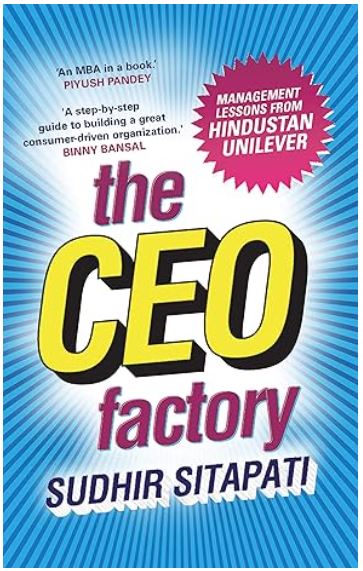
The CEO Factory: Management Lessons from Hindustan Unilever
Sudhir Sitapati is the Managing Director and CEO of Godrej Consumer Products Limited, taking up the post in October 2021. Prior to this, Sudhir was the Executive Director – Foods and Refreshments at Hindustan Unilever Limited (HUL). He was with HUL for ~23 years across divisions and has worked on many brands including Lifebuoy, Pepsodent, Fair & Lovely, Kissan, Dalda, Surf Excel, Brooke Bond, and/even on Horlicks & Boost (from the acquisition of Glaxo Consumer in India). In the book, he has put forward his views on the functioning of various business functions at HUL. Sudhir has used lot of anecdotes and quotes from his bosses/peers in his book. Another great feature is summary of the chapter in 5-6 bullet points at the end of every chapter.
The author has given a good history of Unilever and HUL and set the context of importance of HUL in the daily life of Indians as consumers and contribution to the corporate India. He says ~90% of Indian households use an HUL product every month – this is quite true, as the breadth & depth of HUL brands and products canvasses so many segments in our daily lives. As per Sudhir, there are ~400 HUL alumni who are currently holding CXO position in different Indian companies. This is where he calls HUL as “the CEO factory” and throughout the book he has listed traits and qualities of the organisation which makes HUL the company it is today.
Sudhir has articulated the HUL story across the key functions of marketing, advertising, product development, pricing & sales along with finance & HR.
Middle-class soul: One key trait identified with HUL is “the middle-class soul”; which is embedded in the mindset of the target consumers – aspirational, yet conservative on costs. The culture of the company and target audience has been about hard-work, frugality and high ambitions. This will be true to many successful companies in India. However, any company which can sustain this culture and maintain success for so long is to be commended. There are many references to the gruelling training programme which HUL gives it new joinees. This involves going out in scorching sun and torrential rain to meet distributors in remote towns to make daily sales calls. Furthermore, this connects them to the market.
Marketing: As per the author, marketing is the most important part in a business and good CEOs are usually good marketing people. He talks about his marketing lessons from his MBA days (quotes his former IIM-A professor), his experience of working on different brands. He talks about ‘Job to be done’ (JTBD) process, which is the HUL way to frame and structure the problem. The same was applied when HUL bought GlaxoSmithKline India in 2018. Sudhir has narrated 2 stories on the overextension of brands which led to collapse in sales and a rebrand or rename – Dove was introduced to save Lux, and Rin Supreme was renamed Surf Excel Bar to save Rin. A couple of insights, which I found interesting: “Those with money are thrifty, those without splurge”. He has cited a couple of examples to elaborate this.
Advertising: Sudhir has highlighted in detail the communication strategy and the process at HUL for any advertisement. There are details on getting the media planning right, selecting the right medium based on cost. He has given example of how they effectively communicated Lifebuoy’s changing message – from being seen as a masculine brand to a brand which helps to prevent children falling ill by protecting against germs. In fact, Lifebuoy is also one of the rare brands, which has extended its brand – from just soap to a liquid handwash. The author also highlights the role of getting the right product and its quality. In quality, it is extremely important that the product delivered to a customer is the same as designed in laboratory.
Pricing: One of the most basic ways of HUL’s way of pricing model is to fix the price consumer will pay, and then work backwards on cost with a margin. On discounts, his take is it doesn’t lead to new customers, but leads to more volumes by existing customers. Similarly, low price point is important than being cheaper. However, one can’t compromise with quality because of selling at lower price point – this is applicable especially for sachets. By giving products at lower price point, the product’s access improves rather than affordability. The book also gives details on how overstocking any commodity or waiting endlessly for price drop screws up the pricing strategy. The same was observed in HUL (2007-10) and a few other companies later as well.
Sales: A quote this chapter starts with is: “Sales is a cost centre and not a revenue centre”. This implies the focus should be on availability of right products/stock-keeping unit (SKU); at the same time quantity of the right SKU plays an equally important role. Sudhir recalls one of the first task every HUL management trainee is taught is to calculate distributor return on investment (RoI). This entails how high stock rotation helping in managing working capital and increases its RoI even in lower margins. Wholesalers are also interested in high-rotation products and not in high-margin products.
I thoroughly enjoyed reading this book. It is a very easy-to-read book, and has lot of anecdotes and live examples, which any investor and keen observer will recognise. It covers lot of interesting insight on the marketing of consumer-driven businesses. Overall, this book gives one a peak into the mindset of the Indian consumer and how HUL has adapted to changes/challenges.
Saurabh Chugh
July 2024
